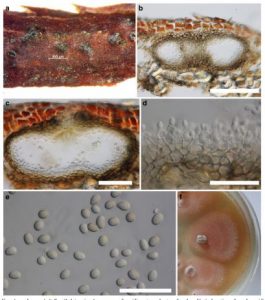Neomicrosphaeropsis italica Thambugala, Camporesi & K.D. Hyde, sp. nov. Index Fungorum number: IF552090
Etymology: Named after the country (Italy), where the holotype was collected.
Holotype: MFLU 16–0674
Saprobic or weak pathogen on twigs of Tamarix species. Sexual morph: Undetermined. Asexual morph: Conidiomata 95–200 μm high × 200–270 μm diam. (x = 142 × 228 μm, n = 8), pycnidial, scattered or solitary, immersed, slightly erumpent, black, globose to subglobose, uni- to multi-loculate, ostiolate. Conidiomatal wall 18–40 μm (x = 28 μm, n = 15), consisting of light to dark brown, thick-walled cells of textura angularis, becoming hyaline towards the conidiogenous region. Conidiogenous cells 2.5–5(−6.4) × 1.8–3.1(−4) μm (x = 4.3 × 2.5 μm, n = 15), enteroblastic, phialidic, hyaline, cylindrical, discrete or integrated, smooth. Conidia 3.6–6.2 × 2.9–4.6 μm (x = 5.1 × 3.8 μm, n = 60), hyaline to light brown, aseptate, obovoid to ellipsoidal, smooth-walled.
Culture characteristics: Conidia germinating on PDA within 18 h. Colonies growing on PDA reaching 14 mm diam. After 7 days at 25 °C, circular, flat, surface pinkish white, surface smooth with entire to curled edge.
Material examined: ITALY, Province of Ravenna [RA], Lido di Dante, on dead branches of Tamarix sp. (Tamaricaceae), 7 December 2014, Erio Camporesi IT 2286–2 (MFLU 16–0674, holotype), ex-type living culture MFLUCC 15–0485, ICMP 21253; ibid. (GZAAS, isotype); ibid. 24 December 2014, Erio Camporesi IT 2286 MFLUCC 15–0484; ibid. IT 2287–2 (MFLU 16–0663, paratype), living culture MFLUCC 15–0487; Province of Ravenna [RA], Lido di Dante, on dead branches of Tamarix sp. (Tamaricaceae), 19 March 2015, Erio Camporesi IT 2421–1 (MFLU 16–0675, GZAAS), living culture MFLUCC 16–0284, GZCC 15–0049.
FIG Neomicrosphaeropsis italica (holotype) a Appearance of conidiomata on host surface b, c Vertical sections through conidiomata d Conidiogenous cells and developing conidia e conidia f Culture growing on PDA. Scale bars: b = 100 μm, c = 50 μm, d, e = 25 μm

